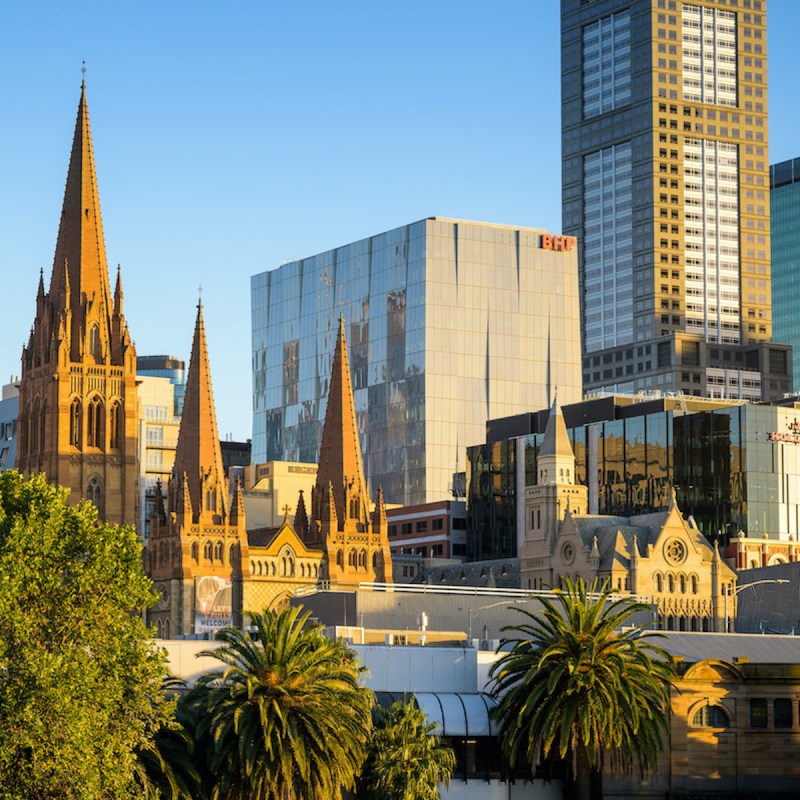
By the 1880s, Melbourne had developed an international reputation as one of the greatest cities in the world. Mark Twain praised the city when he visited in 1895, and British journalist George Augustus Sala dubbed the metropolis “Marvellous Melbourne” in 1885. Augustus Sala has come and gone, but his term for the city stuck.
Videos by TravelAwaits
Melbourne has skyscrapers, street art, and modern transportation. But despite this modern veneer for locals like me, after living here for 60 years, the best spots to see are the more historic places intertwined with our history.

1. Spires To Inspire
My aunt visited us from England when I was a child. I was surprised when she wanted me to accompany her inside St. Paul’s Cathedral. I’m also indebted because she taught me to see the beauty in ecclesiastical architecture.
Diagonally opposite Flinders Street Station, St. Paul’s was built in the Gothic Revival style, the spires echoing the grand medieval cathedrals. The foundation stone was laid in 1880. Step inside for a wonderland of carvings, alabaster, marble, Venetian glass mosaics, and stained glass. The central spire is the second-highest in the Anglican Communion, after Salisbury Cathedral. It’s open Tuesday–Saturday from 10 a.m.–3 p.m. with free admission and self-guided tours.
St. Patrick’s Cathedral (1858–1940) is dedicated to Ireland’s patron saint. It’s the largest church building in Australia. The bluestone cathedral is Gothic and formidable. I’ve walked past at night and imagined Nosferatu creeping behind the iron fencing. St. Patrick’s was designed by William Wardell, Melbourne’s foremost ecclesiastical architect of the era. Seen from above, the building forms a Latin cross. Outside, walk the Pilgrim Path, absorbing the calming sounds of running water and spiritual quotes before exploring the gargoyles and spires. There is a cathedral shop and no entrance fee. Close to the stunning Fitzroy and Treasury Gardens, it’s a gorgeous walk.

2. Gape At Gold
A walk down fashionable Collins Street is a must-do in Melbourne. At the top is the Old Treasury Building, commissioned in 1857 to store the gold bullion pouring into Melbourne from the Victorian goldfields. Enjoy free entry and exhibits.
Continue walking down the Paris End of Collins Street, a tree-lined boulevard with luxe shops including Hermes, Dior, Fendi, Versace, Cartier, and Tiffany & Co.
Continue on the golden mile to the banking precinct. Victoria’s gold rush (from 1851 to the late 1860s) funded a boom of neo-Gothic and Italianate banks and insurance buildings. My favorite is the ANZ Gothic Bank, the finest secular Gothic-Revival building in Australia. The outside, with its towers and turrets, looks like a fairytale castle. But inside, the palatial Venetian-Gothic-style interior is breathtaking. No expense was spared: massive columns and vaulted, hand-painted ceilings dripping with 23-karat gold leaf. It features enough gold to stretch around the equator, so the legend goes. Note the leadlight window of the miner panning for gold (the foundation of the bank’s wealth). As with St. Patrick’s, the architect was William Wardell.
Pro Tip: Don’t miss the ornate Old Safety Deposit Building next door or 333 Collins Street to walk through an incredible banking chamber.

3. Unravel The Maze
Tourists who find themselves walking up Swanston Street, past tacky tourist shops, may mutter, “Well, this isn’t very interesting.” They should leave this main drag and turn down one of the laneways to discover Melbourne’s hidden charms. Surveyor Robert Hoddle designed Melbourne as a grid back in 1837. The population couldn’t be bothered walking the long way round when their destination was nearby, so he developed a warren of well-trodden laneway shortcuts. Once home to alley cats and trash cans, these days, the laneways are famous for street art, one-off boutiques, galleries, hidey-hole cafés, and secret bars. Join a walking tour, download a map, or follow a local.
“Doing the block” is a term from the 1860s–1930s that referred to well-dressed people promenading along Collins Street between Elizabeth and Swanston Streets. It was once the place to see and be seen, and for chance encounters with the opposite sex. Carpenters Lane became known as the Block Arcade after this practice. When a fire gutted the area, it was redesigned as a shopping arcade in 1892, inspired by Milan’s Galleria Vittorio Emanuele. The Victorian-era arcade features mosaic-tiled floors, stained-glass windows, a glass canopy and skylights, and carved stone finishes. It’s still a place to be seen.
Pro Tip: The Hopetoun Tea Rooms were in the arcade for 128 years. They are in the process of shifting to larger premises. Locals will follow as their cakes are deservedly famous.

4. Gin And Sin In Little Lon
Little Lon was a notorious slum associated with prostitution, opium dens, and petty crime. In 1948, the government cleaned up the area replacing ramshackle homes with office towers. Digging these foundations resulted in huge holes, and Little Lon became the site of archaeological digs that revealed much of the area’s fascinating history.
Number 17 Casselden Place was the only 19th-century, single-story building to avoid demolition. Once a brothel and a sly grog shop, today, it’s a cottage housing Little Lon Distillery, a boutique bar and gin distillery.
Sip cocktails and drink in Little Lon’s infamous characters as the gins are named after the locals. Ginger Mick was a legendary local larrikin. Arthur “Dutchy” Thomas was a hooligan, and his namesake gin is full of swagger and Dutch courage. The lychee-infused Little Miss Yoko references Yokohama, a prostitute of Chinese descent working out of the cottage for over 15 years. The 10-foot gin still is housed in her former room of “business.” And Proudfoot (a London dry gin) takes its name from the constable who patrolled the area and liked to stop in for “a cup of tea.”
Bookings are recommended. The gin masterclasses offer cocktails, tastings, and a fascinating history lesson. Take home the spirit of Melbourne in a bottle.
Pro Tip: Melbourne Historical Crime Tours run tours of Little Lon.

5. Divine Domes
You can’t judge a book by its cover, but you can judge a city by its library. The State Library of Victoria is renowned for its stunning domed reading room. Built in 1913, the dome was then the largest reinforced-concrete structure in the world and was inspired by the domes at the British Museum and Washington’s Library of Congress.
The magnificent octagonal reading room is six stories high and houses 32,000 books. Many of Melbourne’s literary elite come here to write. Take a photo of the Dome either looking up or from the heights of the sixth-floor balcony. Officially called the Latrobe Reading Room, locals still call it the Dome. Ask for directions when you enter the library.
Across the road from the library, Coop’s Shot Tower is inside Melbourne Central under a glass dome. The workers would climb up 300 stairs before pouring molten lead through a sieve. When the lead hit the water far below, it had formed into a circular shot for muskets. Coop’s Shot Tower was the tallest building in Melbourne’s Central Business District (CBD) until the mid-1940s. When the shopping center was built in the 1980s, architects preserved this piece of Melbourne’s history inside a glass-and-steel dome. Admission is free.

6. Historic Homes
The National Trust of Australia (Victoria) protects and conserves historical places. Visit Como House and Garden in upmarket South Yarra. Built in 1847, the grand house is a mix of Australian Regency and classic Italianate architecture, offering a glimpse into the privileged lifestyle of its former owners, the Armytage family.
However, my favorite National Trust property closest to Melbourne’s CBD is Ripponlea Estate. The house was built in 1868 for Frederick Sargood, who made his money selling goods in the goldfields. The most striking feature is the 14-acre Victorian pleasure garden, a tranquil oasis with meandering paths, century-old trees, a lake with bridges, and even a grotto.
Both homes are featured in the popular Australian detective series Miss Fisher’s Murder Mysteries.

7. Historical Stays
To stay on theme, Melbourne has historic hotels. The Treasury on Collins Apartment Hotel is in the historic banking precinct. The Hotel Windsor is next to the Princess Theatre, but it seems a little tired these days.
I recently enjoyed a stay at the Rendezvous Hotel Melbourne. Built in 1913 as the Commercial Travellers Club, the building has been restored to its original splendor in a multi-million dollar refurbishment retaining old-world charm but introducing modern conveniences.

Designed by Harry Tompkins, the building is one of Melbourne’s finest and most distinct expressions of the Edwardian Baroque style. Step inside the hotel’s Grand Vestibule, a word meaning “entrance court,” and look up at stained-glass windows, pillars, and the ornate circular ceiling. Enjoy the elegance and decadence of bygone times by indulging in a high tea or drinks in the Travellers Bar.
Rendezvous Hotel is on Flinders Street, close to Melbourne’s historic station, and a short stroll from the famous laneways. A 10-minute walk in the opposite direction leads to Southbank for al fresco riverside dining and Melbourne’s Cultural Precinct.
Many tourists stay in Southbank’s towering modern hotels, but I prefer the “Marvellous Melbourne” charm of somewhere like the Rendezvous Hotel. The building has connections to Sidney Myer (Australia’s Mr. Selfridge), who established Myer emporiums on Bourke Street in 1911.

Pro Tip: Request a heritage room as these have the original leadlight windows and high, ornate ceilings. Some have views over the Yarra River. Rooms here are surprisingly affordable.

8. Exhibitionism
The Melbourne Museum is a post-modernist building walkable from the city near Queen Victoria Market. See the life-size dinosaurs and walk through the Forest Gallery — a replica of Victoria’s mountain landscape complete with tall eucalypts, ferns, and even mists. The Little Lon Collection can be found in the Melbourne Story exhibition.
The Royal Exhibition Building, adjacent to the museum in the Carlton Gardens, is the museum’s largest exhibit. Designed for the 1880 Melbourne International Exhibition, the UNESCO World Heritage-listed Royal Exhibition Building has been charming and terrifying Melburnians ever since. Terrifying, as this is where many of us sat for our exams, the stunning building is one of the last remaining 19th-century exhibition buildings in the world.

9. A Funny Thing Happened On The Way To The…
London’s theatrical heartland is the West End. In Melbourne, we call our theater district the East End. The Princess Theatre was established in 1854 but rebuilt in 1886 using a design from architect William Pitt. Famous thespians, such as Sir Laurence Olivier, Marlene Dietrich, and Ralph Richardson, have trodded the boards of the East End. Restored to its former glory in the 1980s by the Marriner Group, the theater holds 1,500 people and is home to blockbuster musicals. It’s currently showing Harry Potter and the Cursed Child.
The Regent Theater began operating as a picture palace in 1929. Today, it seats 2,145 patrons. The audience sits on two levels under the original chandeliers. The forthcoming program includes Moulin Rouge, Rodgers and Hammerstein’s Cinderella, Hairspray, and Joseph and the Amazing Technicolor Dreamcoat.

My favorite theater is Forum, on the corner of Russell Street and Flinders Street. Designed by American architect John Eberson, the exterior features Moorish-Revival minarets and turrets. Inside are Greco-Roman columns, classical statues, marble staircases, and a Mediterranean sky — Citroen blue with twinkling stars and projected passing clouds.
The Forum is where I saw one of my first movies, The Age of Consent, in 1969. Helen Mirren played a nubile teenager. Both the Forum and Helen Mirren, who is now 76, continue to astound us. And so does “Marvellous Melbourne.”
Check out all there is to do in the Land Down Under:
